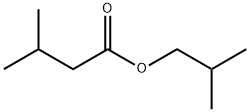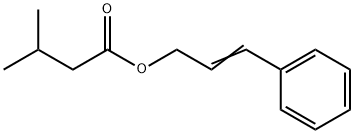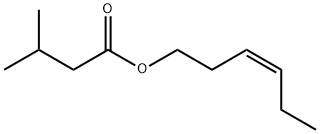Butyl isovalerate
- CAS NO.:109-19-3
- Empirical Formula: C9H18O2
- Molecular Weight: 158.24
- MDL number: MFCD00048775
- EINECS: 203-654-7
- SAFETY DATA SHEET (SDS)
- Update Date: 2024-12-18 14:15:30

What is Butyl isovalerate?
Description
Butyl Isovalerate is a clear liquid. Molecularweight =158.27; Boiling point = 150℃; Flash point =53℃. Hazard Identification (based on NFPA 704 M RatingSystem): Health 0, Flammability 2, Reactivity 0. Insolublein water.
Chemical properties
Butyl Isovalerate is a clear liquid. B.P. 167℃. Sp.Gr. 0.86. Almost insoluble in water, soluble in Propylene glycol, miscible with alcohol and most oils. Ethereal-fruity, Apple-like, somewhat pungent odor. Sweet-fruity taste, reminiscent of Apple, Raspberry, with a winey note.
Chemical properties
Butyl isovalerate has an odor reminiscent of the isobutyl ester with a sweet, apple-like taste.
Occurrence
Reported found in the oil from leaves of Eriostemon coxii and Phebalium dentatum; also in apricot, banana, cheeses, olive and plum.
The Uses of Butyl isovalerate
Butyl isovalerate is occasionally used in flavor compositions, mainly in Chocolate flavors and fantasy fruit or Tutti-frutti, etc. Concentrations are normally about 50 ppm in the finished product.
Preparation
By prolonged boiling of the acid with n-butyl alcohol in benzene in the presence of concentrated H2SO4. By direct esterification of n-Butanol with iso-Valerie acid under azeotropic conditions.
Definition
ChEBI: Butyl 3-methylbutanoate is a fatty acid ester.
Taste threshold values
Taste characteristics at 5 ppm: fruity, sweet, pineapple, ripe, musty and green with a slight cheesy nuance.
Potential Exposure
May be used as a specialty solvent; food additive
First aid
If this chemical gets into the eyes, remove anycontact lenses at once and irrigate immediately for at least15 min, occasionally lifting upper and lower lids. Seek medical attention immediately. If this chemical contacts theskin, remove contaminated clothing and wash immediatelywith soap and water. Seek medical attention immediately. Ifthis chemical has been inhaled, remove from exposure,begin rescue breathing (using universal precautions, including resuscitation mask) if breathing has stopped and CPR ifheart action has stopped. Transfer promptly to a medicalfacility. When this chemical has been swallowed, get medical attention. Give large quantities of water and inducevomiting. Do not make an unconscious person vomit.
storage
Color Code—Red: Flammability Hazard: Store in aflammable liquid storage area or approved cabinet away fromButyl isovalerate 479ignition sources and corrosive and reactive materials. Prior toworking with this chemical you should be trained on itsproper handling and storage. Before entering confined spacewhere butyl isovalerate may be present, check to make surethat an explosive concentration does not exist. Store in tightlyclosed containers in a cool, well-ventilated area. Metal containers involving the transfer of this chemical should begrounded and bonded. Where possible, automatically pumpliquid from drums or other storage containers to process containers. Drums must be equipped with self-closing valves,pressure vacuum bungs, and flame arresters. Use only nonsparking tools and equipment, especially when opening andclosing containers of this chemical. Sources of ignition, suchas smoking and open flames, are prohibited where this chemical is used, handled, or stored in a manner that could create apotential fire or explosion hazard
Shipping
UN3272 Ethers, n.o.s., Hazard class: 3; Labels: 3—Flammable liquid. UN1993 Flammable liquids, n.o.s., Hazard Class: 3; Labels: 3—Flammable liquid, Technical Name Required
Incompatibilities
Vapor may form explosive mixture with air. Reaction, possibly violent, on contact with oxidizers. Compounds of the carboxyl group react with all bases, both inorganic and organic (i.e., amines) releasing substantial heat, water and a salt that may be harmful. Incompatible with arsenic compounds (releases hydrogen cyanide gas), diazo compounds, dithiocarbamates, isocyanates, mercaptans, nitrides, and sulfides (releasing heat, toxic and possibly flammable gases), thiosulfates and dithionites (releasing hydrogen sulfate and oxides of sulfur)
Waste Disposal
Dissolve or mix the material with a combustible solvent and burn in a chemical incinerator equipped with an afterburner and scrubber. All federal, state, and local environmental regulations must be observed.
Properties of Butyl isovalerate
| Melting point: | -92.8°C (estimate) |
| Boiling point: | 175 °C(lit.) |
| Density | 0.858 g/mL at 25 °C(lit.) |
| refractive index | n |
| FEMA | 2218 | BUTYL ISOVALERATE |
| Flash point: | 145 °F |
| form | clear liquid |
| color | Colorless to Almost colorless |
| Odor | at 100.00 %. apple pear fruit sweet pineapple green peach |
| Odor Threshold | 0.012ppm |
| JECFA Number | 198 |
| BRN | 1752803 |
| CAS DataBase Reference | 109-19-3(CAS DataBase Reference) |
| NIST Chemistry Reference | Butanoic acid, 3-methyl-, butyl ester(109-19-3) |
| EPA Substance Registry System | Butyl isovalerate (109-19-3) |
Safety information for Butyl isovalerate
| Signal word | Warning |
| Pictogram(s) |
 Exclamation Mark Irritant GHS07 |
| GHS Hazard Statements |
H315:Skin corrosion/irritation H319:Serious eye damage/eye irritation H335:Specific target organ toxicity, single exposure;Respiratory tract irritation |
| Precautionary Statement Codes |
P261:Avoid breathing dust/fume/gas/mist/vapours/spray. P264:Wash hands thoroughly after handling. P264:Wash skin thouroughly after handling. P271:Use only outdoors or in a well-ventilated area. P280:Wear protective gloves/protective clothing/eye protection/face protection. P302+P352:IF ON SKIN: wash with plenty of soap and water. P305+P351+P338:IF IN EYES: Rinse cautiously with water for several minutes. Remove contact lenses, if present and easy to do. Continuerinsing. |
Computed Descriptors for Butyl isovalerate
| InChIKey | AYWJSCLAAPJZEF-UHFFFAOYSA-N |
New Products
4-Fluorophenylacetic acid 4-Methylphenylacetic acid N-Boc-D-alaninol N-BOC-D/L-ALANINOL Tert-butyl bis(2-chloroethyl)carbamate 3-Morpholino-1-(4-nitrophenyl)-5,6-dihydropyridin- 2(1H)-one Furan-2,5-Dicarboxylic Acid Tropic acid S-2-CHLORO PROPIONIC ACID ETHYL ISOCYANOACETATE 2-Bromo-1,3-Bis(Dimethylamino)Trimethinium Hexafluorophosphate (6-METHYL-[1,3]DITHIOLO[4,5-b]QUINOXALIN-2-ONE INDAZOLE-3-CARBOXYLIC ACID 4-IODO BENZOIC ACID (2-Hydroxyphenyl)acetonitrile 4-Bromopyrazole 5,6-Dimethoxyindanone 2-(Cyanocyclohexyl)acetic acid 4-methoxy-3,5-dinitropyridine 2-aminopropyl benzoate hydrochloride 1-(4-(aminomethyl)benzyl)urea hydrochloride diethyl 2-(2-((tertbutoxycarbonyl)amino) ethyl)malonate tert-butyl 4- (ureidomethyl)benzylcarbamate Ethyl-2-chloro((4-methoxyphenyl)hydrazono)acetateRelated products of tetrahydrofuran








You may like
-
 Butyl Isovalerate CAS 109-19-3View Details
Butyl Isovalerate CAS 109-19-3View Details
109-19-3 -
 Butyl Isovalerate CAS 109-19-3View Details
Butyl Isovalerate CAS 109-19-3View Details
109-19-3 -
 Butyl isovalerate CAS 109-19-3View Details
Butyl isovalerate CAS 109-19-3View Details
109-19-3 -
 Butyl isovalerate CAS 109-19-3View Details
Butyl isovalerate CAS 109-19-3View Details
109-19-3 -
 1975-50-4 98%View Details
1975-50-4 98%View Details
1975-50-4 -
 2-HYDROXY BENZYL ALCOHOL 98%View Details
2-HYDROXY BENZYL ALCOHOL 98%View Details
90-01-7 -
 14714-50-2 (2-Hydroxyphenyl)acetonitrile 98+View Details
14714-50-2 (2-Hydroxyphenyl)acetonitrile 98+View Details
14714-50-2 -
 118753-70-1 98+View Details
118753-70-1 98+View Details
118753-70-1